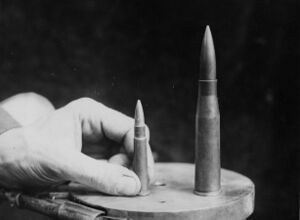Engineering:13.2mm TuF
| 13.2mm TuF (Tank und Flieger) | ||||||||
|---|---|---|---|---|---|---|---|---|
 Comparison of British .303 and German 13.2mm Tuf | ||||||||
| Type | Rifle/machine gun | |||||||
| Place of origin | Germany | |||||||
| Service history | ||||||||
| In service | 1918–1919[citation needed] | |||||||
| Used by | Germany | |||||||
| Wars | World War I | |||||||
| Production history | ||||||||
| Designed | 1917 | |||||||
| Specifications | ||||||||
| Bullet diameter | 13.2 mm (0.525 in)[1] | |||||||
| Neck diameter | 14.6 mm (0.57 in) | |||||||
| Shoulder diameter | 19.1 mm (0.75 in) | |||||||
| Base diameter | 20.9 mm (0.82 in) | |||||||
| Rim diameter | 23.1 mm (0.91 in) | |||||||
| Case length | 91.3 mm (3.59 in) | |||||||
| Overall length | 132.6 mm (5.22 in) | |||||||
| Ballistic performance | ||||||||
| ||||||||
| Test barrel length: 39" | ||||||||
The Mauser 13.2mm TuF (German: Tank und Flieger; lit. "tank and aircraft", known also as 13.2×92mmSR) cartridge, was a major step in the development of anti-tank cartridges, being the first one designed for the sole purpose of destroying armored targets.
History
The cartridge was used in the Mauser 1918 T-Gewehr rifle. Its use was also planned in a new machine gun scheduled for deployment in 1919, the MG 18 TuF.
The 13.2 mm Tuf was designed to counter early British tanks which made their appearance during late World War I. Since a tank's path was difficult to determine prior to its deployment near the front, land mines were difficult to employ as a deterrent to their forward passage. Light artillery pieces pressed into service as anti-tank guns were very effective, but cumbersome and difficult to bring into action quickly enough. Thus, another means of combating these early armored vehicles needed to be found. Since early plate armor was relatively thin due to the need to reduce vehicle weight for low-powered drive trains to propel the unit (and since tanks were mainly designed to protect from machine-gun fire), large-bore rifles could be used to harass and kill tank crews.[2]
When word of the German anti-tank round spread, there was some debate as to whether it should be copied and used as a base for the new machine gun cartridge. However, after some analysis, an exact copy of the German ammunition was ruled out, its performance was inferior to the later .50 BMG (which some maintain is just enlarged .30-06 Springfield round, which in itself is a modification of an earlier German Mauser round), and because it was a semi-rimmed cartridge, making it sub-optimal for an automatic weapon despite it being designed for that purpose, although others have stated the .50 BMG is nothing more than a rimless necked down copy of the German round. That said, when the U.S. military learned of the German round the .50 BMG was still on the drawing boards and the fact that the .50 BMG was started prior to discovery of the German round can in no way rule out the often stated belief that the German round played a significant part in formulating the .50 BMG round, even if the latter emerged with significantly different ballistic characteristics. Despite an effort by some to claim the .50 BMG was without any outside influences many sources still continue to mention the association between the two rounds,[3] which seems to have at least some merit given the documentary evidence.
Design
The 13.2 Tuf utilized a 92 mm-long semi-rimmed case featuring a shallow bottle-neck. It was developed by the Polte ammunition factory in Magdeburg, Germany.[4][2]
See also
References
- ↑ "13x92 SR - MUNICION.ORG". http://old.municion.org/13x92sr/13x92sr.htm.
- ↑ 2.0 2.1 "Mauser Model 1918 T-Gewehr". https://www.militaryfactory.com/smallarms/detail.php?smallarms_id=452.
- ↑ Barrett Tillman, American Rifleman,February 23, 2017, https://www.americanrifleman.org/articles/2017/2/23/the-50-cal-browning-machine-gun-the-gun-that-won-the-war/
- ↑ "HISTORIC FIREARM OF THE MONTH, February 2002". http://www.cruffler.com/Features/FEB-02/historic-february02.html.
- "An Introduction to Anti-Tank Rifle Cartridges" by Anthony G. Williams

